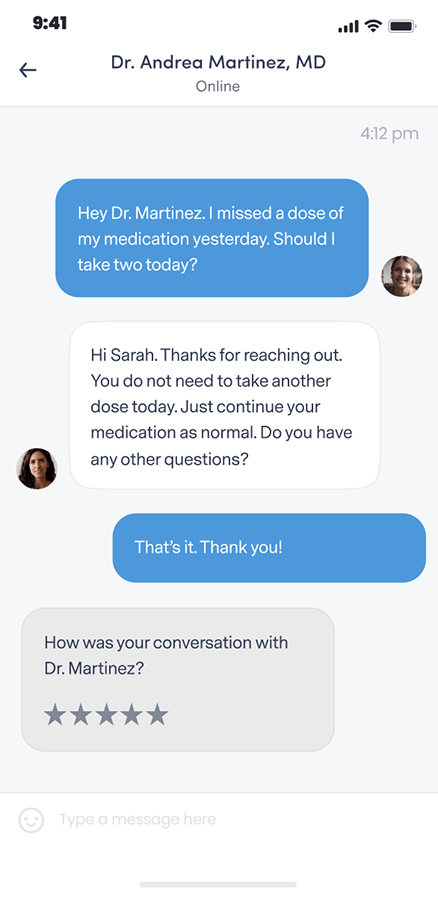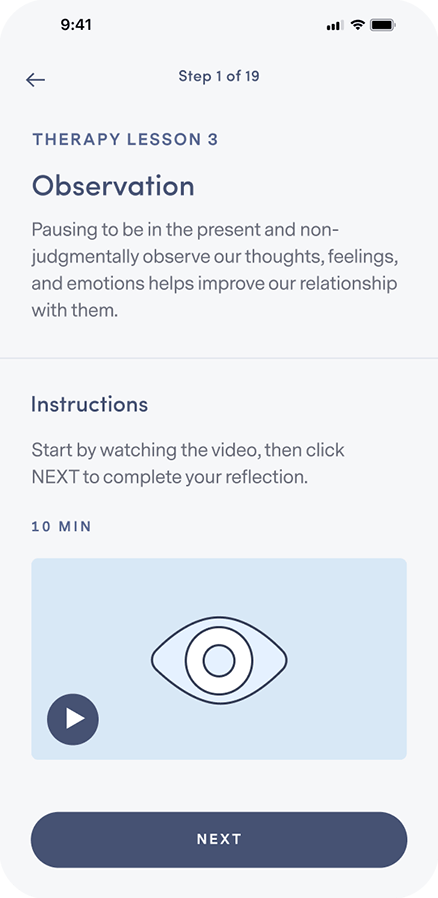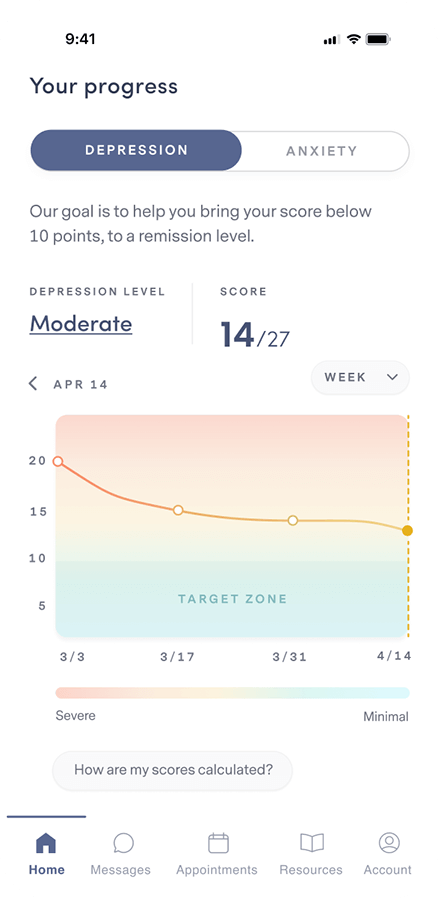Member Spotlight: Chelle’s Story
Mental illness affects people just like me. Mental illness affects people different from me. You can’t just “snap out of it.” And it’s...
HOW WE TREAT PANIC DISORDER
Our providers understand the challenges of panic disorder, and have real-world experience helping people just like you.
Start with a free assessment
Our Care
Different people experience panic disorder in different ways. That’s why our providers work 1:1 with you to personalize treatment to your unique needs.
When medication is necessary, our psychiatric providers analyze 100+ data points to determine the most tolerable and effective prescription for you.
Our program combines cognitive and behavioral therapy with independent skill practice—all of which have been clinically proven to work for a wide range of symptoms.
Mental Health condition
A panic attack is the abrupt onset of intense fear or discomfort that reaches a peak within minutes and includes at least four of the symptoms below.

A panic attack is a strong physical reaction accompanied by feelings of fear that suddenly come on and can last for several minutes. When you have a panic attack, you may sweat profusely, feel short of breath, and experience chest pains that may feel like you’re having a heart attack. These are all reasons why panic attacks can be very frightening and uncomfortable.
People who experience repeated panic attacks often become anxious and preoccupied with having another attack and may make changes to their lifestyle to avoid having panic attacks. If you have experienced four or more panic attacks or live in fear of having another attack, you may have a panic disorder.

Someone may be diagnosed with panic disorder if they experience sudden and repeated panic attacks, a feeling of being out of control, of death, or impending doom during a panic attack. They may also be diagnosed with panic disorder if they experience intense worry about when or where the next panic attack will happen and fear or avoid places where panic attacks have occurred in the past for 30 days or more.
HOW IT WORKS

Let your provider know how you’re feeling, get to know you, and provide 1:1 support.

Get questions or concerns off your chest between video visits by messaging your provider at any time.

Learn how to integrate new thought and behavior patterns into your daily life.

Complete weekly check-ins so your provider can track your progress and, if necessary, adjust your treatment and/or medication.
Our plan options
Because quality mental health care shouldn’t be out of reach for anyone.
PERSONALIZED
clinically-proven
comprehensive
Free Assessment
86% of our members feel better within 12 weeks.
We accept insurance.





FREQUENTLY ASKED QUESTIONS
If your question isn’t answered below, view our full list of FAQs here.
Brightside is available to people 18 years and older in the states where Brightside operates who believe they may be experiencing depression and may benefit from treatment.
Remote care is not a good fit for people with certain conditions or situations. These include (but are not limited to):
Our providers do not treat, and do not prescribe for adhd.
If any of these describe you, it’s best for you to be seen by a provider in person so you can get the care that’s right for you.
Brightside makes it easy to get top quality depression care from the privacy of home.
Here’s how Psychiatry works:
Here’s how Therapy works:
When scheduling your first appointment, you can browse all of our available providers in your state. Take a look at their profiles and check open times to find the best fit for you. Every Brightside provider undergoes a rigorous hiring and vetting process to ensure the highest quality care.
Brightside currently accepts select insurance plans in various states for payment of your provider’s or therapist’s services. Please see below for a current listing of plans. Brightside may not be included in all plans that each health insurance company offers. Please contact your health insurance plan to verify that your care at Brightside will be covered.
We currently accept the following insurance plans:
If you are a new member signing up for services you can enter your insurance information during the sign-up process. We’ll let you know your eligibility, as well as you estimated co-pays and out-of-pocket costs (if any) before signing-up or scheduling.
We also accept HSA/FSA payment if you have one of those accounts. If you have questions about using your medical or prescription insurance benefits, please contact us by emailing [email protected].
Although research has not wholly determined why some people develop panic disorder, researchers believe that the illness may be caused or triggered by one or a combination of genetic or hereditary factors, a more sensitive “fight-or-flight” response, a disturbance in neural pathways in the brain, a stressful life event, or childhood stress and trauma.
Visit a doctor if you’ve been experiencing symptoms of panic disorder. At first, it may be difficult to discuss your feelings, but remember that your doctor is there to help you. Speaking openly about your condition is the first step toward healthily managing your symptoms.
The first thing to do is to talk to your doctor about your symptoms. Your doctor will do an exam and ask you about your health history to ensure that an unrelated physical problem is not causing your symptoms. Your doctor may then refer you to a mental health specialist, such as a psychiatrist or psychologist.
You may be diagnosed with panic disorder if you have regular and unexpected panic attacks followed by at least a month of continuous worry or concern about having further attacks.
If you have panic attacks but have not been diagnosed with a panic disorder, you can still benefit from treatment. If panic attacks aren’t treated, they can get worse and develop into panic disorder or phobias.
Once a diagnosis has been established, a panic disorder is generally treated with therapy, medication, or both. Talk with your provider about the best treatment option for you.
Therapy: A type of treatment called cognitive behavioral therapy (CBT) is especially useful as a treatment for panic disorder. CBT teaches you different ways of thinking, behaving, and reacting to the feelings that come on with a panic attack. CBT can help you become aware of inaccurate or negative thought patterns to view challenging situations more clearly and respond to them more effectively. The attacks can begin to disappear once you learn to respond differently to the physical sensations of anxiety and fear during panic attacks.
Medication: Doctors also may prescribe different types of medications to help treat panic disorder, depending on your needs. These medications can include:
SSRIs and SNRIs are both antidepressants commonly used to treat depression, but they are also helpful for panic disorder symptoms. The results of these medications are not immediate—they may take several weeks to start working. These medications may also cause side-effects, such as headaches, nausea, or difficulty sleeping. These side effects are usually not severe for most people, especially if the dose starts low and increases slowly. Most of the time, the benefits of the medication outweigh the potential side effects but talk to your doctor about any that you may be experiencing. Check out our Myths and Misconceptions about Antidepressants post for more information about antidepressants.
You should work closely with your doctor to find the best medication and dose for you. Both therapy and medication can take some time to work, so don’t give up on treatment too quickly. Following a healthy lifestyle can also help combat panic disorder. Make sure to get enough sleep and exercise, eat a healthy and balanced diet, and turn to loved ones who you trust for support.